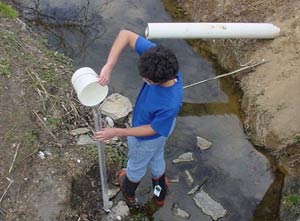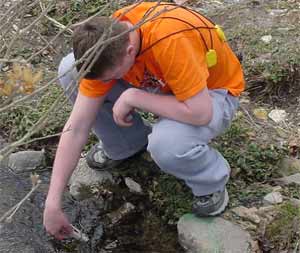Stars and STEM Stories
Model School: Pennsylvania School Integrates GLOBE Protocols into Existing Science Curriculum

When High School science teacher Todd Toth returned from a weeklong GLOBE training back in April of 1995, he got a pleasant surprise: His building principal suggested he develop a new science elective based on what he had learned. Over the next few years, Todd developed what is now the "Environmental Research" course, which is sponsored by California University of Pennsylvania as an equivalent to their freshman level earth science course. The seniors (and a few juniors) who earn an 'A' or 'B' letter grade in his class also earn 3 college credits.
"Integrating the GLOBE protocols has really helped us counteract the old complaint 'why should I learn this, I'll never use it,'" says Toth.
A major benefit of the Environmental Research course is that it allows students to apply the principles learned in math and science classes they took as underclassmen. "Integrating the GLOBE protocols has really helped us counteract the old complaint 'why should I learn this, I'll never use it,'" says Toth. "Well, with GLOBE and the way we have designed this course students need to draw from earth science, chemistry, physics, biology, algebra, etc."
The class explores a variety of topics that he integrates with the GLOBE protocols:
- Expository Writing Assignments - Students view non-narrated NASA videos and explain the main theme and key ideas/concepts being presented. (As in any writing assignment, spelling, punctuation, grammar, etc., all count towards the final grade.)
- Remote Sensing Unit - Students begin with road maps, moving up to contour maps, aerial photos of home and school buildings, satellite imagery of hometown and 3D modeling software. They utilize GLOBE visualization activities.
- Meteorology Unit - The Waynesboro High School has a digital weather station which has greatly enhanced curriculum in this area. This also makes it easier to use the atmospheric protocols, and has made it possible for his class to become part of the Homeland Security Weather Network, which allows students to interact with meteorologists in the Washington D.C. area. This weather station along with contacts at the National Climatic Data Center (NCDC) has provided students with data for the next area of study - climatology.
- Climatology Unit - Students create monthly weather profiles which provide the local newspaper with weather related data. At the end of the year students create a 12-month profile of weather conditions for that particular year. This data is also archived so future classes can use them for comparison. The class has access to local weather data for the past 109 years so Toth has students look for patterns or trends in the weather. The students use these observations to try to dispel local gossip about how dry or wet the past season has been. Students are also provided data and articles to read about worldwide climate changes and look specifically at ice core sampling, El Niño and La Niña events and the role of oceans in influencing certain weather conditions.
Toth notes that the principal of the Waynesboro High School supports the success of the Environmental Research class in a variety of ways, including trying to schedule the class as close to solar noon as possible so the students can get the most out of the GLOBE protocols as they can. The Waynesboro school site consists of a high school, middle school, elementary school and plenty of open grass land in between. Between the high school and middle school are a spring-fed stream and a 1/3 acre pond they use for many of the hydrology measurements. Along with the GLOBE protocols students measure stream volume and velocity. Students have also had the opportunity to beta test - and then keep - some equipment, such as water vapor meters, sun photometers and a HOBO data logger for soil temperatures. Students worked with and emailed results to the scientists involved during the beta testing period.

At the end of the year, Toth takes students to one of two local state parks where they have a hands-on final. The students must demonstrate an understanding of each GLOBE protocol and be able to operate any equipment associated with that particular protocol. They must find each of the protocol sites by using maps and a GPS unit and then save the data to a GPS unit showing their return route. "The students love this as their final, and I love teaching this class!" says Toth.
28 April 2006





